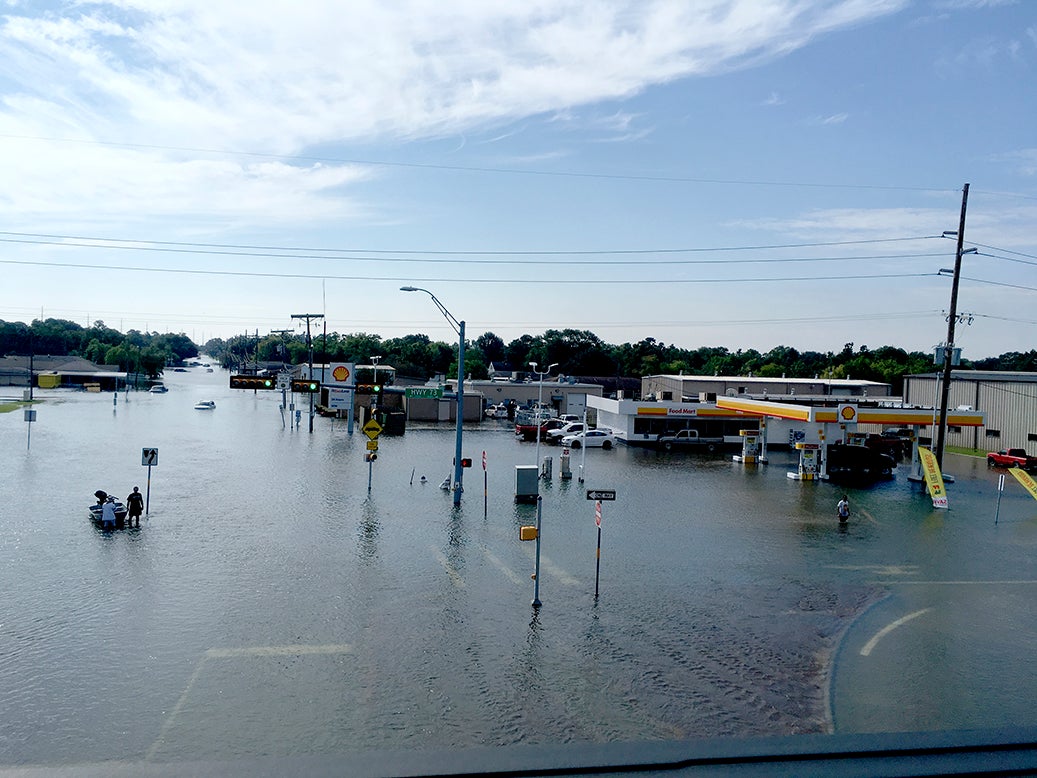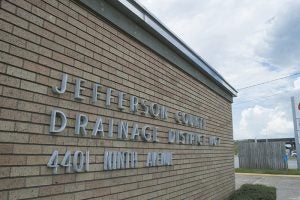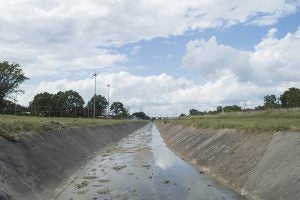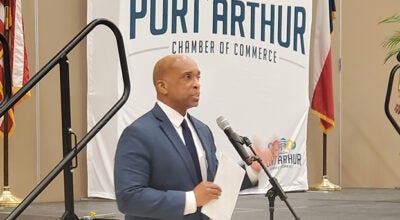High water in a low land: Why we flooded—And why we might again, no matter what we do
Published 10:51 am Saturday, September 30, 2017

- Jesse Wright/The News A view of 9th Avenue, Aug. 31. Port Arthur found itself underwater after Tropical Storm Harvey and though residents have been quick to blame DD7, experts say Port Arthur may never be able to handle that much rain, no matter what.
By Josh Bergeron
josh.bergeron@salisburypost.com
In the early hours of Aug. 30, Drainage District 7 staff averted a potentially massive failure.
As Tropical Storm Harvey’s floodwater rose, the largest pump station in Drainage District 7 began to take on water.
Harvey’s bands of rain brought historic amounts of rain to southeast Texas, and floodwater rose high enough to penetrate small gaps between steel pipes and a concrete wall at the Alligator Bayou pump station, said District Manager Phil Kelley. By about 2 a.m. on Aug. 30, water on the station’s bottom floor reached chest-level, Kelley said.
Knowing the consequences of water rising further, DD7 staff maneuvered a submersible pump into the flooded area to move water out of the station.
“Had we not been able to get that water out, we would have jeopardized losing the whole station,” Kelley said.
Alligator Bayou drains water for about 60 percent of DD7. In optimal conditions, its capacity is 2.2 million gallons per minute, which breaks down to roughly 560,000 gallons per minute, per pump.
Machines that provide lubricant to the pumps could have stopped because of floodwater inside of the station, Kelley said. Eventually, the pumps could have stopped. By pumping water out of the station, DD7 avoided a pump failure that would have affected a majority of the district. Had the pump failed entirely, it could have turned a bad situation into the worst situation.
That grim but bright spot might be cold comfort for the hundreds who are homeless and for the thousands whose lives were torn asunder and by those seeking answers to the question on everyone’s mind.
How could things have gone so wrong?
As it stands, at least one law firm is sniffing for signs of incompetence — the makings of a class action suit. But so far, independent experts say the same thing: The true cause of the flooding lies in the heavens, in the storm clouds overhead, and the monstrous record rainfall they let loose.
And it could happen again. And, the experts say, there might not be much anyone can do to prevent a flood next time, either.

Josh Bergeron / Port Arthur News – Jefferson County’s Drainage District No. 7’s pump station worked until one ran out of gas during Tropical Storm Harvey. The district’s operations during the storm, however, have come under scrutiny because of massive flooding across the area.
Mostly, the pumps worked as intended
With one exception, pumps operated continuously as rain fell across DD7. On Aug. 28, staff filled diesel fuel tanks at every site. By the afternoon of Aug. 30, fuel levels began to run low. That evening, the Crane Bayou station completely emptied its tanks and stopped pumping water, Kelley said.
But, according to official accounts, that is the only pump that went down during the flooding.
Nevertheless, much of Port Arthur experienced severe flooding and so, when Harvey’s floodwater receded, locals had questions.
Residents questioned whether pumps and other infrastructure moved water fast enough and how a pump running out of fuel affected flood levels and whether DD7 staff performed proper equipment maintenance prior to the event.
Meanwhile, Beaumont-based law firm Reaud, Morgan and Quinn has raised the possibility of a class action lawsuit, and their recent public meetings have attracted hundreds of people.
Victims of the flood want closure for a storm that upended lives and ruined homes and business.
And the drainage district finds itself examining what improvements are cost effective and even possible.
Jeff East, a surface water specialist at the Texas Water Science Center, said he’s not aware of any drainage system that could have handled Harvey’s rainfall. In a matter of days the storm dumped a year’s worth of rain in an area that’s relatively flat and close to sea level, East said.
“It would be a significant engineering challenge to design a well-functioning, cost-effective drainage system that could handle that amount of rain,” he said.
More value in finding answers
Ambre Bushong, who lived near the Jack Brooks Regional Airport, said she understands that Harvey dropped historic amounts of rain — one gauge measured nearly 65 inches near her house — but questions how her neighborhood saw major flooding.
The neighborhood, Dominion Ranch, borders a drainage canal, but it also sits at a higher elevation than other areas of Port Arthur. The adjacent airport saw little, if any, flooding. Meanwhile, Bushong said water began to build up in her neighborhood several days before the worst rain bands from the storm.
Bushong said she and her husband Aldo Chavera Jr. didn’t purchase flood insurance because they were not in a flood zone and many people advised them not to.
“Probably like three people in our entire neighborhood had insurance,” she said.
Brandon Corley also lived in Dominion Ranch before the storm. Corley recalled flooding occurring before the storm’s worst bands of rain, but water initially drained relatively well.
“The water would come up, but after it stopped raining for a while it would go down,” he said.
As an example, he said the neighborhood was flooded for most of the day on Aug. 28. By that afternoon, water had completely receded. On the morning of Aug. 29, floodwater rose higher than ever before, he said. When rain stopped, water didn’t recede. Floodwater inundated the neighborhood.
Bushong says she’s not sure whether a class-action lawsuit against DD7 is worth joining. Corley said he may participate. Plaintiffs in the lawsuit could receive a financial settlement, Bushong said, but it won’t be enough to cover the cost of rebuilding or provide closure for people who lost everything.
“You’re never going to get back what you lost,” she said. “There are people who lost 50 years’ of stuff, and no amount of money is going to replace everything.”
More than a lawsuit, Corley said there’s value in finding answers to questions.
‘We’re here to answer questions’
Beaumont law firm Reaud, Morgan and Quinn hasn’t yet filed a lawsuit, and attorney Adam Nichols said it’s not clear yet whether one will be filed.
“At this point, we’re just looking into what happened with DD7,” he said. “We’re investigating.”
Earlier this month, the firm held a public meeting in Groves that attracted hundreds of people. Residents were asked to sign up for a potential suit and were offered information about government programs. A similar meeting Thursday attracted between 40 and 50 people.
Kelley said he hasn’t received documents from the Beaumont firm about the lawsuit. Asked about the potential suit, he stressed the quality of work performed by DD7 employees under stressful conditions.
“I think under the circumstances my guys persevered,” Kelley said. “The bottom line is, we live here too. Our families live here — brothers, sisters, mothers. Why would we not do our job and risk everybody?”
‘Everything was upside down by then’
As Harvey caused flooding, DD7 staff worked in two, 12-hour shifts. Pump stations operated “wide open for several days,” Kelley said.
Stephen Barbini, who rescued dozens of people from flooded homes on Linkwood Street, said a DD7 employee remained at a nearby pump station even as rescues occurred hundreds of yards away.
At 7 p.m. on Aug. 29, a shift change was scheduled, but DD7 employees couldn’t leave their posts because of floodwater. Some would have been stuck at work anyway as their replacements were stranded, stuck by the flood.
By 8 p.m. rescues had already started in Port Arthur and Groves.
By 3 a.m. or 4 a.m. on Aug. 30, Kelley said standing water in his office rose high enough to begin spilling into his boots. At the time, he was alternating between phone calls with emergency personnel, DD7 staff and county leaders.
“We had to keep going,” he said. “I just kept looking at the wall while I’m on the phone and watching the water come up … Two of my supervisors had already been in a couple times and said ‘look, you’ve got to get out of here.’”
Initially, Kelley didn’t budge.
“‘Look, go do what you need to do. I’m busy,’” he recalled telling the two DD7 staff members.
That evening — Aug. 30 at 5 p.m. — tanks for the Crane Bayou pump station, near Procter Street extension, began to run low, Kelley said. DD7 employees started shutting off the station’s smallest pumps to conserve fuel for larger ones. By 9 p.m., no fuel remained, and DD7 employees either shut off the remaining pumps or the pumps operated until shutting off themselves.
Kelley said fuel tanks at the pump station’s sites usually last for three days, but adverse conditions during Harvey decreased the time to which fuel lasted.
He addressed criticism about running low on fuel by saying flood water submerged a number of DD7’s fuel trucks. In addition, loading areas at local refineries were not open because of floodwater.
Kelley said he’s not sure whether Crane Bayou’s fuel shortage worsened flooding across a specific area, but by the time its pumps stopped “everybody had already flooded.”
“Everything was already upside down by then,” he said.
At one point, Alligator Bayou — the largest pump station in DD7 — started to run low on fuel, but crews delivered a load of fuel before it was too late.
Bushong and others questioned the quality and frequency of maintenance on drainage pumps. Kelley said he feels confident about the quality of maintenance. Employees also regularly perform maintenance on the pumps, but Kelley said no specific schedule of maintenance exists.

Josh Bergeron / Port Arthur News – A small stream of water flows down a drainage canal in Port Arthur weeks after Harvey’s floodwater ravaged the area. Following massive flood water from Harvey, operations of Drainage District 7 have come under scrutiny.
Time for infrastructure improvements?
Asked about flooding in the Port Arthur area, East said the Texas Gulf Coast’s topography didn’t help. The slope and elevation of land traditionally dictate how well water drains in an area, he said.
He said any drainage system would be stressed to move the amount of water dropped by Harvey in a period of less than a week.
Still, local officials and residents are advocating for major infrastructure improvements.
Port Arthur City Councilman Willie “Bae” Lewis Jr. said major upgrades need to be made to DD7, which is independent of city government, and the city’s drainage pumps and canals, which feed into DD7. Specifically, Lewis said, DD7 and city government need to increase pumping capacity and elevate pumps above flood levels
“Not spending money is not an option,” he said.
Asked about the cost of such an endeavor, Lewis said the city could use grants from the Federal Emergency Management Agency and other organizations.
“We’ll be in a better position now, after the storm, to get the grants and make these corrections without a tax increase,” he said.
Meanwhile, Kelley says there’s “not enough money in the word” to build a drainage system that could handle the amount of rain dumped by Harvey.
“And even if it was possible, it would cost billions of dollars,” he said.
Kelley said he and County Judge Jeff Branick recently requested $200 million worth of mitigation funding for DD7 improvements. Kelley said Texas Gov. Greg Abbott will include that amount in a much-larger, federal mitigation funding request.
The Army Corps of Engineers also could provide more than $700 million for levee improvements as part of an ongoing study from Sabine Lake to Galveston, Kelley said.
Authorities will seek state and federal funds first to pay for any upgrades, as the only alternative is a local tax hike.
Kelley wouldn’t say explicitly whether a tax increase might be needed for future improvements. However, Kelley said he doubts that the local tax base could support drainage improvements that would have handled Tropical Storm Harvey’s floodwater anyway.
Editor’s note: This article has been updated to correct the spelling of Brandon Corley’s name.





